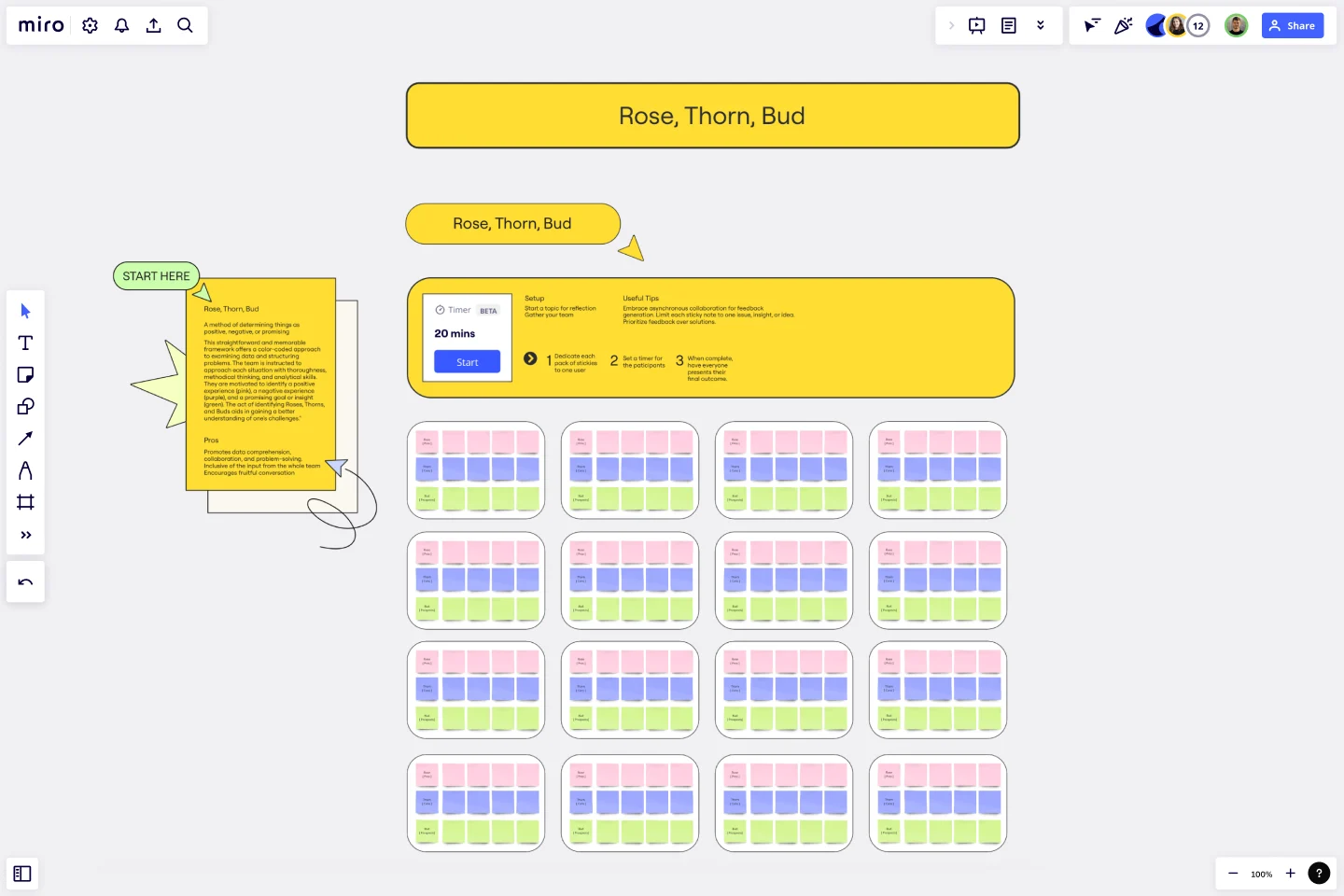Rose Thorn Bud Template
Categorize things as positive, negative, or promising with the Rose Thorn Bud Template.
About the Rose Thorn Bud Template
The Rose Thorn Bud Template provides a clear and comprehensive approach to analyzing data and structuring problems. The team is instructed to approach each situation with thoroughness, methodical thinking, and analytical skills. They are motivated to identify positive experiences (pink), negative experiences (purple), and promising goals or insights (green).
By using this framework, the team can better understand the challenges they face and develop effective strategies to overcome them. Identifying Roses, Thorns, and Buds encourages the team to think critically and creatively and approach problems with a positive and proactive mindset. This framework is valuable for any team looking to improve their problem-solving skills and achieve their goals.
Benefits of using the template
Promote data comprehension, collaboration, and problem-solving.
Inclusive of the input from the whole team.
Encourage fruitful conversation.
How to use the template in Miro
Dedicate each pack of stickies to one user.
Set a timer for the participants.
When complete, have everyone present their final outcome.
Setup
Start a topic for reflection.
Gather your team.
Useful tips
Embrace asynchronous collaboration for feedback generation.
Limit each sticky note to one issue, insight, or idea.
Prioritize feedback over solutions.
Get started with this template right now.
Infographic Template
Works best for:
Marketing, Desk Research, Documentation
As we bet you’ve experienced, data can get pretty dense and dry. But you need it to be compelling, memorable, and understandable. The solution? Infographics. These are tools that let you present information in a visually striking way and turn quantitative or qualitative data into stories that engage and resonate. Whoever you’ll be presenting to — customers, donors, or your own internal teams — our template will let you design an infographic that combines text and visuals to break down even the most complicated data.
Video Storyboarding Template
Videos can be a game-changer when presenting a new idea. To create an engaging video, structure your narrative effectively using a Video Storyboarding Template. This ensures your message is clear and easy to understand and can help you gain support and feedback.
Agile Kata Storyboard
Works best for:
Storyboard, Design, Planning
Optimize your Agile processes with the Agile Kata Storyboard template. This template is ideal for Agile teams looking to improve their workflows and problem-solving techniques. It helps you visualize the steps of the Agile Kata, including problem identification, solution brainstorming, and iterative testing. Use this template to facilitate continuous improvement, enhance team collaboration, and ensure your Agile practices are effective and efficient.
Empathy Mapping by ServiceNow
Works best for:
Research & Design, Market Research
The Empathy Mapping template helps teams capture detailed user insights. By understanding user perspectives, you can improve product features and customer satisfaction. This template is perfect for user research and product development.
UX Research Repository Template
Works best for:
UX Design, User Experience
Empower your organization with customer knowledge and build a centralized research hub. From UX designers to product managers, enable everyone to get insights using the Research Repository Template.
Empathy Map [Research]
Works best for:
Market Research, Research & Design
Empathy Map Research template helps you gather in-depth user insights. It’s designed for teams who want to understand user behaviors and needs better. Use this template to inform your design decisions and create user-centered products.

